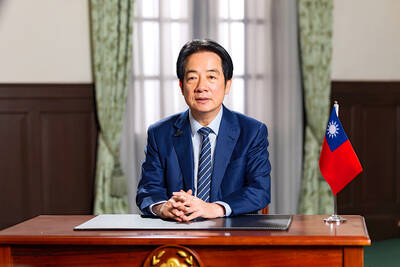The 20-year efforts to recover the once “little-known” history of prisoners of war (POW) captured by Japan during World War II and interned in POW camps on Taiwan, has borne fruit as a book that is to come out next year.
Hundreds of people on Sunday gathered at the site of the former Kinkaseki POW Camp in Jinguashi (金瓜石), New Taipei City as Taiwan POW Camps Memorial Society held the 20th Remembrance Day service to pay tribute to former POWs who had suffered or perished in Taiwan.
Greeting the family members of those POWs was the typical damp weather for northeastern Taiwan. Ann Buckles, whose father Frederick West was with the Royal Engineers of the British Army, said that retracing her father’s footsteps let her feel what he went through.

Photo: Yu Chao-fu, Taipei Times
“We are here on a rainy day, but they had to work in the rain,” said Buckles, who came to Taiwan on behalf of her father who spent three years as a POW after being captured in Singapore in 1942.
“It’s so good to know where he was so I can visualize it all now.” Buckles said she never heard anything about POW camps from her father and she thought that “it was just too horrible for them to say.” However, the history should not be forgotten, Buckles said.
“We must never forget what they have done. They shaped our whole future. Britain wouldn’t be a country if they hadn’t fought the war. We owe them so much,” Buckles said.
Nick Beecroft, 57, from England, said his father said “almost nothing” about his experience in the POW camps, “apart from humorous anecdotes.” His father Thomas Beecroft was also captured in Singapore and held in various POW camps in Taiwan.
“Somehow, I didn’t like to ask. It seemed like intrusion on his pain,” Nick Beecroft said when he recalled his father’s enjoyment working in the insurance industry after the war. “He didn’t like to speak about it, and wanted to move on with his life.”
Nick Beecroft came with his son Charles Beecroft who initiated the idea. “I never met him, but being here today made me feel so close to him,” Charles Beecroft said. According to Taiwan POW Camps Memorial Society, over 4,350 Allied POWs were held in 16 POW camps in Taiwan from 1942 to 1945 and more than 10 percent of the POWs died in captivity from starvation, sickness, overwork and beatings by cruel guards.
GONE BUT NOT FORGOTTEN
The dark history was hardly known until information about Kinkaseki POW camp came to light in 1996. The next year, Michael Hurst, a Canadian expat in Taiwan and director of the Taiwan POW Camps Memorial Society, began to organize efforts to restore the history.
In her reading at the service, Fiorelle Amore, granddaughter of George Ferguson who was with 5th Field Regiment Royal Artillery of British Army, said that all POWs have a common wish to pass along to future generations. Amore said that her grandfather passed away when she was 14 or 15 years old.
She said that her family could only piece together information they obtained from his friends to know what might have happened to him. Over the past 20 years, Taiwan POW Camps Memorial Society has located all the 16 camps and contacted more than 500 former Taiwan POWs and their family members for the “little-known” stories to finally be told, Hurst said.
HUSHED UP
“Now those wonderful men who thought no one cared about them, no one loved them, no one appreciated what they have done and suffered here, they now know for sure that they have not and will not ever be forgotten,” Hurst said at the ceremony. Hurst said that when he started the work, the history was unknown in the UK and the US.
“Because when they went home from the war, the British and the American governments told them not to talk about it.” Hurst said that he has amassed a large collection of sources from family members of POWs, including diaries, transcriptions of diary and notes, etc. He has been working on a book about the history of Taiwan POW camps, expecting to publish it next year.
After the English version is published, Hurst said they will translate it into Chinese so as to help Taiwanese gain a deeper understanding of the country’s history.
The book could be the first one about the history of Taiwan POWs. Speaking on behalf the Commonwealth and Allied countries at the ceremony, Representative of Australian Office Catherine Raper, said that Remembrance Day is an opportunity to remember all the history and to recall the courage and the sacrifice of those who will continue to preserve democracy and freedom.
“It’s our duty and our honor to remember” and to pass the remembrance on to the next generation, Raper said. Director of the New Zealand Commerce and Industry Office Moira Turley, British Office Taipei Representative Catherine Nettleton and Director of American Institute in Taiwan Kin Moy also joined the service in honor of the veterans.
They joined family members of POWs in laying wreaths on the memorial to conclude the ceremony.

This month the government ordered a one-year block of Xiaohongshu (小紅書) or Rednote, a Chinese social media platform with more than 3 million users in Taiwan. The government pointed to widespread fraud activity on the platform, along with cybersecurity failures. Officials said that they had reached out to the company and asked it to change. However, they received no response. The pro-China parties, the Chinese Nationalist Party (KMT) and Taiwan People’s Party (TPP), immediately swung into action, denouncing the ban as an attack on free speech. This “free speech” claim was then echoed by the People’s Republic of China (PRC),

Exceptions to the rule are sometimes revealing. For a brief few years, there was an emerging ideological split between the Democratic Progressive Party (DPP) and Chinese Nationalist Party (KMT) that appeared to be pushing the DPP in a direction that would be considered more liberal, and the KMT more conservative. In the previous column, “The KMT-DPP’s bureaucrat-led developmental state” (Dec. 11, page 12), we examined how Taiwan’s democratic system developed, and how both the two main parties largely accepted a similar consensus on how Taiwan should be run domestically and did not split along the left-right lines more familiar in

Many people in Taiwan first learned about universal basic income (UBI) — the idea that the government should provide regular, no-strings-attached payments to each citizen — in 2019. While seeking the Democratic nomination for the 2020 US presidential election, Andrew Yang, a politician of Taiwanese descent, said that, if elected, he’d institute a UBI of US$1,000 per month to “get the economic boot off of people’s throats, allowing them to lift their heads up, breathe, and get excited for the future.” His campaign petered out, but the concept of UBI hasn’t gone away. Throughout the industrialized world, there are fears that

The Democratic Progressive Party (DPP) controlled Executive Yuan (often called the Cabinet) finally fired back at the opposition-controlled Legislative Yuan in their ongoing struggle for control. The opposition Chinese Nationalist Party (KMT) and Taiwan People’s Party (TPP) acted surprised and outraged, but they should have seen it coming. Taiwan is now in a full-blown constitutional crisis. There are still peaceful ways out of this conflict, but with the KMT and TPP leadership in the hands of hardliners and the DPP having lost all patience, there is an alarming chance things could spiral out of control, threatening Taiwan’s democracy. This is no